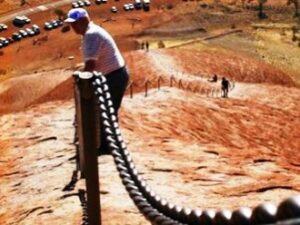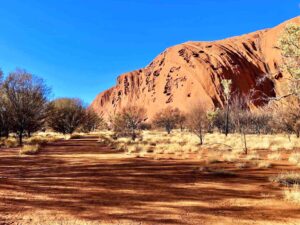» posted on Tuesday, July 26th, 2022 by Linda Lou Burton
The Big Red Rock
Originally Published July 26, 2020 by Linda Lou Burton posting about Uluru, Australia from Little Rock, Arkansas – Australian English defines a “walkabout” as a journey (originally on foot) that is made by an Australian Aboriginal in order to live in  the traditional manner. It’s also been defined as a spiritual or ceremonial journey, a rite of passage, a chance to be alone, or the opposite, to wander among people. My NDI RTW is a “walkabout” of sorts, a pause in routine to wander, observe the world, and to think. Like my Journey Across America – two years on the road, just me and the cats, paying attention, learning. I am not a tourist.
the traditional manner. It’s also been defined as a spiritual or ceremonial journey, a rite of passage, a chance to be alone, or the opposite, to wander among people. My NDI RTW is a “walkabout” of sorts, a pause in routine to wander, observe the world, and to think. Like my Journey Across America – two years on the road, just me and the cats, paying attention, learning. I am not a tourist.
What will I learn in my two-night stay near Uluru? I’m booked at the Ayers Rock Resort Sunday and Monday nights, and that puts me into the tourist category I suppose, so I’ll talk about “the naming” issue first; a story of what was, what happened, and what is going on today at the Big Red Rock that means “Australia” all over the world.
 The Big Red Rock is sandstone, 2,831 feet of it; 1,142 feet are above ground. It has a perimeter of 5.8 miles. It appears to change color at different times of the day; it glows red at dawn, and sunset. There are a number of springs, waterholes, and rock caves in the area, which is 208 miles southwest of Alice Springs. It is a UNESCO World Heritage Site and a major tourist attraction. And it is controversial.
The Big Red Rock is sandstone, 2,831 feet of it; 1,142 feet are above ground. It has a perimeter of 5.8 miles. It appears to change color at different times of the day; it glows red at dawn, and sunset. There are a number of springs, waterholes, and rock caves in the area, which is 208 miles southwest of Alice Springs. It is a UNESCO World Heritage Site and a major tourist attraction. And it is controversial.
Archaeological finds indicate that humans have inhabited the area for more than 10,000 years, but Europeans didn’t arrive until the 1870s. William Gosse, one of the first British explorers in the area, named the Big Red Rock Ayers’ Rock, in honor of the Chief Secretary of South Australia, Sir Henry Ayers. But the people already living there called the Big Red Rock Uluru. It was a sacred place, a part of their creation story.
In a sequence of events much like America’s history, further European exploration followed; resources were documented as land for farming or mining; fences were erected and claims made. The British concept of fences and property boundaries was unknown to Australia’s native population, who lived a more nomadic life, following resources as nature provided. Due to the new restrictions and effects of grazing and drought, bush food stores soon were depleted; competition for resources created conflict. Interaction between natives and white settlers became frequent, and sometimes violent.
Between 1918 and 1921, large adjoining areas of South Australia, Western Australia, and the Northern Territory were declared Aboriginal reserves. The Petermann Reserve included Uluru, or Ayers Rock. In 1940, the Petermann Reserve was made smaller, to allow people to look for gold; in 1958 it was made smaller again when the government created the Ayers Rock-Mt Olga National Park.
 Bill Harney was the first Park Ranger; by 1959, the first motel leases had been granted and an airstrip constructed close to the northern side of Ayers Rock. In 1963, a chain was added to assist tourists in climbing the rock. The development of tourism produced adverse environmental impacts; in the early 1970s all accommodation-related tourist facilities were moved outside the Park. A 40-sq mile area nine miles from Ayers Rock was developed with tourist facilities and an airport; it became known as Yulara. In 1992, the Northern Territory government sold its majority interest in the Yulara resort and it was renamed Ayers Rock Resort. And that is where I’m staying, in a “room with a view,” that allows me to sleep, and wake, with the Big
Bill Harney was the first Park Ranger; by 1959, the first motel leases had been granted and an airstrip constructed close to the northern side of Ayers Rock. In 1963, a chain was added to assist tourists in climbing the rock. The development of tourism produced adverse environmental impacts; in the early 1970s all accommodation-related tourist facilities were moved outside the Park. A 40-sq mile area nine miles from Ayers Rock was developed with tourist facilities and an airport; it became known as Yulara. In 1992, the Northern Territory government sold its majority interest in the Yulara resort and it was renamed Ayers Rock Resort. And that is where I’m staying, in a “room with a view,” that allows me to sleep, and wake, with the Big  Red Rock watching over me.
Red Rock watching over me.
Who “owns” the rock today, I wondered. Digging deeper, I learned that in 1985 the Australian government returned “ownership of Uluru” to the Pitjantjatjara Aborigines, with the condition that the local Aṉangu would lease it back to the National Parks and Wildlife agency for 99 years and that it would be jointly managed.
The agreement that the “climb to the top” by tourists would be stopped was not kept. The local Aṉangu do not climb Uluru because of its great spiritual significance. They request that visitors do not climb the rock, partly because the path crosses a sacred traditional Dreamtime track, and also out of a sense of responsibility for visitors safety. Yet until October 2019, the Park Visitors Guide said “the climb is not prohibited, but we prefer that, as a guest on Aṉangu land, you will choose to respect our law and culture by not climbing.”
According to a 2010 publication, just over one-third of all visitors to the Park climbed Uluru; a high percentage of these were children. It is a steep hike, and often quite windy. There have been at least 37 deaths since such recreational climbing deaths were recorded. Several controversial incidents on top of Uluru including a striptease, golfing, and nudity, led to renewed calls for banning the climb. In November 2017, the Uluṟu–Kata Tjuṯa National Park board voted unanimously to prohibit climbing Uluru. There was a surge in climbers and visitors after the ban was announced! But the ban went into effect October 26, 2019, and the climbing chain was removed.
 There are many other trails and walks available in the Uluṟu–Kata Tjuṯa National Park, where close to half a million visitors come every year. Tomorrow I’ll go walkabout, respectfully, at the Big Red Rock called Uluru; the Base Walk that goes around the rock’s circumference. I’ll listen to the stories. I’ll wake up early enough to see the sun rise, and watch the red sunset glow.
There are many other trails and walks available in the Uluṟu–Kata Tjuṯa National Park, where close to half a million visitors come every year. Tomorrow I’ll go walkabout, respectfully, at the Big Red Rock called Uluru; the Base Walk that goes around the rock’s circumference. I’ll listen to the stories. I’ll wake up early enough to see the sun rise, and watch the red sunset glow.
And I will dream.
Walks To Read About
https://parksaustralia.gov.au/uluru/do/walks/
https://parksaustralia.gov.au/uluru/pub/visitor-guide.pdf
.
